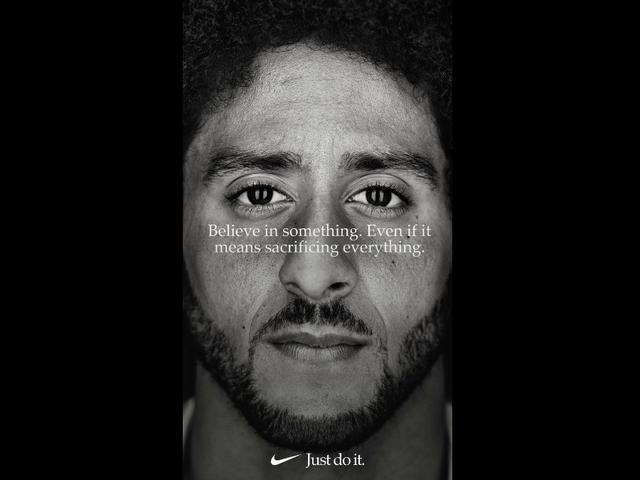
Find a values match between your cause and your constituents’ beliefs
In whatever times we’re in, that’s what folks don’t have enough of. That’s what folks crave.
That’s what explained Nike’s daring move in 2018 to put forward a polarizing marketing campaign featuring the face of American football quarterback Colin Kaepernick, most famously known for taking a knee during the singing of The Star-Spangled Banner.
In Why did Nike do what they did? Mark Schaefer of Grow, and author of several digital marketing books, explains why this was a brilliant idea. Despite the fact it generated controversy, including protesters burning shoes in the streets, Schaefer notes Nike’s move aligns with research highlighted in his book, Marketing Rebellion. The book explores how to connect with customers and build a brand in a world without loyalty.
The message of the book applies to folks in the social benefit sector as well.

You Already Know Most Donors Aren’t Loyal
For at least a decade the Fundraising Effectiveness Project has tracked the dismal donor retention in the nonprofit sector. More folks don’t renew than do. And though there’s been tons of research and wisdom published on how to ameliorate this situation, it’s just not working.
Why?
There are all sorts of reasons, of course. You can read about a ton of them, mostly having to do with poor communication and donor service, here (Adrian Sargeant) and here (Roger Craver). These are important. But I think Schaefer has hit on a big reason most folks in the social benefit sector don’t talk about enough. It has to do with how nonprofits have been taking a cue from business, and trying desperately to define their ‘brand.’
Shaefer’s research shows people today aren’t brand loyal; so energy directed towards branding — too often in and of itself — is largely misplaced.
Branding seems like an important exercise. Yet absent underlying meaning that resonates with your constituency, branding is a hollow endeavor.
It’s ultimately not about who you say you are.
It’s what you do and, most important, how what you do affects people.
The value you deliver is what matters to people.
Donors care less about brand than value.
People are Largely Brand Agnostic
“77% of customers do not want to have a relationship with our brand. In fact, 87% of customers shop around, there’s almost no brand loyalty today.”
Sure, folks care about the environment. But you’re not the only environmental organization competing for their attention.
Sure, folks care about the homeless and the hungry. But you’re not the only emergency assistance organization competing for their attention
Sure, folks care about the arts. But you’re not the only arts organization competing for their attention
Sure, folks care about education. But you’re not the only school or learning organization competing for their attention
Sure, folks care about whatever it is you do, But it’s highly unlikely you’re the only organization enacting your values.
Donors are focused on value.
You need to focus there too!
Value is understood as a clear ‘walking’ of your talk.
Part of that is your expression of authentic gratitude, which engenders trust — the foundation of all lasting relationships.
Donors must know what you stand for, and trust you’ll deliver on your promise.
Stop Defining Yourself by What You’re Not
 Just because you’re a 501 (c) (3) does not make you a ‘good guy’ in the minds of prospective donors.
Just because you’re a 501 (c) (3) does not make you a ‘good guy’ in the minds of prospective donors.
When you define yourself by what you’re not (nonprofit) rather than by what you are (social benefit), your squander the advantage you have over for-profit businesses.
The meaning you deliver is your huge advantage!
The values your organization enacts daily are the values Nike and other for-profit businesses desperately seek to find. Sometimes they’ll even partner with you (cause-related marketing) in order to piggyback on the meaning you deliver. Because people seek purpose, people will align themselves with purpose.
What purpose can you deliver that people are seeking?
Get Inside Your Donor’s Head
 Before you craft any type of communications message, first think about why you’re doing so.
Before you craft any type of communications message, first think about why you’re doing so.
- How do you want the message recipient to feel?
- What to do you want them to think?
- What do you want them to do?
- When do you want them to do it?
Next ask yourself: Will this message achieve these goals?
It’s likely it will not, unless… you think from your donor’s perspective, and answer the WIIFM (What’s In It For Me?) question.
Shift your communications focus to the ways you help donors; not vice-versa.
Here’s one way ‘WIFM’ might look from your donor’s viewpoint:
- This makes me feel sad/angry/worried about the problem that’s been described.
- I think the way they’re planning to address it makes sense.
- Maybe I should make a gift to help.
- I see if I make my gift today it will be matched, so I better do it now.
Once the donor gives, they’ll get a shot of dopamine that translates into “that made me feel good.”
Alas, that feeling will be short lived. Unless you fan the flames.
Hammer Home the Value and Meaning Attached to Giving
 You see, simply giving to you will not be its own reward. The feel good ‘warm glow’ folks get after making a first-time gift is good for a moment.
You see, simply giving to you will not be its own reward. The feel good ‘warm glow’ folks get after making a first-time gift is good for a moment.
Just because someone ‘purchased’ from you once does not mean they’ll do so again, unless…. you do something proactive to positively reinforce the values and meaning underlying the giving impulse.
Without an assist from you, the desire to support your organization will simply evaporate.
People care more about the values underlying your mission than they do about who is enacting those values. If another organization comes along with the same or similar mission, and does a better job of making the donor feel connected to their best self, that organization will reap the donor’s future philanthropy.
One Factor is Associated with Brand Loyalty
 Shared meaning.
Shared meaning.
Nonprofits possess meaning in spades. In fact, all of fundraising simply boils down to a value-for-value exchange.
If you can give back to donors something they value, in exchange for the value they deliver to you, you’re in like Flynn.
Schaefer shares research from Edelman showing more than half of customers seek out brands that align with their values. In fact, they won’t buy absent a feeling the company from which they’re buying aligns with their beliefs. It’s what drives cause marketing, of course. For-profit businesses have a hard time looking like “good guys.”
Delivering value is not the same as simply developing a communications plan to engage with donors. Engagement does not necessarily equal meaning.
In fact, Schaefer busts the myth that, ipso facto, engagement will build the types of relationships that will sustain your organization.. Folks can engage with you numerous times, and still not quite find a reason to trust you. Or a reason to make a philanthropic investment.
You Can’t Inspire Philanthropy Solely Through Engagement
 Too often nonprofits get focused on process.
Too often nonprofits get focused on process.
They’ve heard the process of building relationships is what it’s all about, and mistakenly believe a focus on customer engagement will do the trick. Do you blast out a lot of digital messages, social media posts and various online content describing all the programs you offer, awards you’ve won, services you’re innovating and so forth?
Even if you’re getting a lot of engagement from folks (e.g., follows, retweets, shares, surveys completed, etc.), this won’t necessarily translate to philanthropy.
There is no correlation between customer loyalty and brand interaction.
Loyalty happens when you manage to touch a chord that resonates with the meaning and purpose people seek in their lives.
Press Your Unfair Advantage
 Nonprofits ooze values, purpose and meaning.
Nonprofits ooze values, purpose and meaning.
Values that can potentially align with whoever is encountering you online. Values-based giving is a central way people strive to find meaning and their own sense of purpose.
But… you have to make the case for philanthropy (your connection to ‘love of humanity‘) and put those values out there. BIG TIME.
Sadly, too many nonprofits hide their light under a bushel.
If your values proposition is hard to find, folks will move on.
Proudly Take a Stand
 Don’t just be an arts organization that puts on plays.
Don’t just be an arts organization that puts on plays.
Be an arts organization with a mission that’s larger than what you do. A vision that speaks to the values you enact. A brand that draws folks in because your values align with theirs.
EXAMPLE: San Francisco Playhouse:
Mission: “To share stories that uplift our spirits, deepen self-awareness and nurture a compassionate community.”
Vision: The Empathy Gym
“Our theater is an empathy gym where we come to practice our powers of compassion. Here, safe in the dark, we can risk sharing in the lives of the characters. We feel what they feel, fear what they fear, and love what they love. And as we walk through our doors we take with us greater powers of understanding to make our community a better place, one play at a time.”
“Consumers want brands to take a stand, they need them to take a stand. It is the only thing that results in brand loyalty.”
— Mark Schaefer
Of course, it’s not simply about taking a stand. It’s about taking the right stand.
One that truly reflects your existential reason for being.
Look into Your Organizational Soul
 That’s what Nike did.
That’s what Nike did.
They knew the risk. They weren’t oblivious to the fact they might take a short-term hit. In fact they did, with their stock suffering its biggest single day drop in several months. But they also knew over the long term this strategy would likely pay off by attracting the next generation of young and racially diverse consumers they want as customers. And even in the short term they gambled they would receive a lot of positive publicity. In fact, they did. And the first line of Kapernick Nikes sold out in minutes.
Nike knew their brand, inside and out.
Nike knew the meaning the preponderence of their customers were seeking.
Nike’s marketing strategy aligned beautifully with what they’re known for: Just Do It. And then they added the beautiful line that connects with the meaning all people seek:
“Believe in something.”
Of course, even if you know your heart and soul it doesn’t mean everyone will like you.
Nike lost some customers.
You’ll lose some customers too if you take a stand.
But… you’ll be someone distinguishable from the crowd.
Someone folks can relate to. A brand with whom people can identify. A mission they want to join, because it aligns with their values.
Humans are on a Meaning Quest
 Your job is to facilitate your donor’s philanthropic journey. Their journey to discover their purpose.
Your job is to facilitate your donor’s philanthropic journey. Their journey to discover their purpose.
You may recall the highest level people can reach on Maslow’s pyramid is self-actualization. Maslow posited that once basic security needs are met (food, shelter, safety) we begin to look for other ways to satisfy our existence. We need a raison d’etre beyond mere survival. We seek family, community and belonging. We seek a greater purpose. We seek to identify with the highest version of ourselves. We want to love the person we look at in the mirror.
Help donors channel their values in a positive, expressive direction.
People give when they feel doing so is a genuine expression of who they are.
The believing, and then expressing that belief through doing and giving, is what makes them feel good.
Not engagement, per se.
Meaning.
Never lose sight of the change you’re endeavoring to bring about. That’s the promise folks want to invest in.
Positive, transformative change.






This is very inspirational! I couldn’t agree more, don’t just be an arts organization that puts on plays.
Be an arts organization with a mission that’s larger than what you do. A vision that speaks to the values you enact. A brand that draws folks in because your values align with theirs.